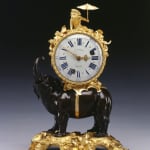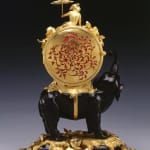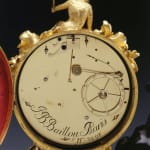Jean-Baptiste Baillon III
Further images
Literature
Hans Ottomeyer and Peter Pröschel, "Vergoldete Bronzen", 1986, p. 124, pl. 2.8.5, illustrating an identical case, the monkey having lost its parasol but likewise with movement by Jean Baptiste Baillon, c. 1750 in the Residenz, Bamberg, Bavaria; another identical case signed on the dial Fieffe de L'Observatoire is housed in Schloss Fasanerie, and pl. 2.8.6, illustrating a comparable clock with elephant looking in the other direction, the case by Jacques Caffiéri, c. 1755 in the Victoria and Albert Museum, London. J. Ramon Colon De Carvajal, "Catalogo De Relojes Del Patrimonio Nacional", 1987, p. 23, no. 4, illustrating an almost identical model with monkey having lost his parasol, in the Spanish Royal collection. Klaus Maurice, "Fine Antique Clocks of the 17th to 19th Century", 1990, pp. 66-67, illustrating a comparable clock surmounted by a monkey with movement by Pierre Flournoy and p. 66, pl. 52 illustrating another elephant clock with surmounting putti, the movement by Beckaert à Paris in the Pitti Palace, Florence and pl. 53 showing an identical case with movement by Baillon in the Residenz Munich. Tardy, "Les Plus Belles Pendules Françaises", 1994, p. 192, col pl. XXXI, showing a very similar clock with standing Chinaman with parasol and dove, the movement by Vautrin à Paris. Jean-Dominique Augarde, "Les Ouvriers du Temps", 1996, p. 90, pl. 55, illustrating an almost identical clock but with monkey holding a parasol in his right hand and seated upon protruding flowers, likewise with movement by Baillon numbered 2398 dated circa 1760, from Baillon's own personal collection. Elke Niehüser, "Die Französische Bronzeuhr", 1997, p. 241, pl. 890, showing an identical clock case. Pierre Kjellberg, "Encyclopédie de la Pendule Française du Moyen Age au XXe Siècle", 1997, p. 126, pl. A, illustrating a very similar clock with movement by Charles le Roy à Paris.
A superb and highly important Louis XV gilt and patinated bronze Pendule 'À L'Éléphant' of eight day duration, signed on the white enamel dial by the renowned clockmaker J. Baptiste Baillon and inscribed on the backplate of the movement J.Bte. Baillon Paris no 3228, housed in a magnificent patinated and gilt bronze attributed to the eminent bronzier Jean-Joseph de Saint-Germain. The white enamel dial with outer Arabic numerals and gilded fleurs-de-lis between the inner Roman numerals, with a fine pair of pierced gilt brass hands for the hours and minutes. The movement with silk thread suspension, verge escapement, striking on the hour and half hour on a single bell, with outside count wheel.The exceptionally fine drum-shaped case decorated by floral garlands surmounted by a seated monkey wearing a tricorn hat and holding a parasol in his left hand, the clock with scrolled base supported on the back of a patinated bronze elephant with gilded girth, raised trunk and feet resting on a foliate rocaille plinth with C-scroll and foliate edge
Paris, date circa 1750
Height 43 cm, width 32 cm.
This famous case model is almost certainly the work of the eminent bronzier Jean-Joseph de Saint-Germain (1719-91). The beauty of the case is equalled by the quality of the movement, made by Jean-Baptiste III Baillon (d. 1772), who was one of the finest makers to have supplied movements for these remarkable and rare clocks including a few with identical cases complete with surmounting monkey. One such example was acquired for the Royal Spanish collection; another is housed at the Residenz Bamberg, a third is in the Munich Residenz. Others include one from the collection of Lord Hillingdon sold in Paris, 1976 as well as another superb example previously sold by this gallery (illustrated in Richard Redding, "Masterpieces of the Past", 2004, p. 67). What makes a Baillon elephant clock even more remarkable is the fact that the clockmaker had one in his own personal collection, (dated circa 1760 and numbered 2398). He also had seven elephant cases in his stock at the time of his death. For further discussions on the case and its maker see p. ?? (old no 65) in this book.
A celebrity in his day, Baillon achieved almost unprecedented success to become, in the words of F.J. Britten "the richest watchmaker in Europe". He was also one of the most important clockmakers of the eighteenth century and undoubtedly the most famous member of a long line of clockmakers. His phenomenal success was largely due to his ability to organise a vast and thriving manufactory on an unprecedented scale. His private factory in Saint-Germain-en-Laye was unique in the history of eighteenth century clockmaking. Managed from 1748-57 by Jean Jodin (1715-61) it continued up until 1765 when Baillon closed it. The renowned horologist, Ferdinand Berthoud was among many to be impressed by its scale and quality and in 1753 noted that Baillon's "House is the finest and richest Clock Shop. Diamonds are used not only to decorate his Watches, but even Clocks. He has made some whose cases were small gold boxes, decorated with diamond flowers imitating nature…His house in Saint-Germain is a kind of factory. It is full of Workmen continually labouring for him…for he alone makes a large proportion of the Clocks and Watches [of Paris]". From there he supplied the most illustrious clientele, not least the French and Spanish royal family, the Garde-Meuble de la Couronne as well as distinguished members of Court and the cream of Parisian society.
Baillon's father, Jean-Baptiste II (d. 1757) a Parisian maître and his grandfather, Jean-Baptiste I from Rouen were both clockmakers, as was his own son, Jean-Baptiste IV Baillon (1752-c.1773). Baillon himself was received as a maître-horloger in 1727. 1738 saw his first important appointment as Valet de Chambre-Horloger Ordinaire de la Reine. He was then made Premier Valet de Chambre de la Reine sometime before 1748 and subsequently Premier Valet de Chambre and Valet de Chambre-Horloger Ordinaire de la Dauphine to Marie-Antoinette, 1770. He was established appropriately at Place Dauphine by 1738 and rue Dauphine after 1751.
To give some idea of the extent of his enterprise, by the time of his retirement the watch movements had reached 4320 and clock movements 3808 in number. His immense fortune was valued at the time of his death, 8th April 1772 at 384,000 livres. His own collection of fine and decorative arts were auctioned on 16th June 1772, whilst his remaining stock, valued at 55,970 livres, was put up for sale on 23rd February 1773. The sale included 126 finished watches, totalling 31,174 livres and 127 finished watch movements at 8,732 livres. The value of his clocks totalling 14,618 livres included 86 clocks, 20 clock movements, seven marquetry clock cases, one porcelain clock case and eight bronze cases of which seven had elephant figures.
Today one can admire Baillon's work in some of the world's most prestigious collections including the Parisian Musées du Louvre, des Arts Décoratifs, National des Techniques, de Petit Palais and Jacquemart-André. Other examples can be found at Château de Versailles; Musée Paul Dupuy, Toulouse; the Residenz Bamberg; Neues Schloss Bayreuth; Museum für Kunsthandwerk, Frankfurt; the Residenz Munich and Schleissheim Schloss. Further collections include the Musées Royaux d'Art et d'Histoire Brussels; Patrimonio Nacional Spain; the Metropolitan Museum, New York; Newark Museum; Walters Art Gallery, Baltimore and Dalmeny House, South Queensferry.
As one of the most important makers of his day, Baillon only used the finest cases and dials. His cases were supplied by the greatest makers of his day including Saint-Germain (who also supplied him with a rhinoceros case) as well as Jean-Baptiste Osmond, Balthazar Lieutaud, the Caffiéris, Vandernasse and Edmé Roy. He also made some of his own models and used the services of the enameller Chaillou and also Antoine-Nicolas Martinière, who supplied him with dials including one for the aforementioned elephant clock previously owned by this gallery.
Elephant clocks have been acquired by some of the most prestigious and discerning collectors of their day. Among them was the duc de Tallard, whose sale in Paris 1756 included a pendule 'à l'éléphant' with movement by Jean-Baptiste Baillon and chimes within an elaborate base. Lazare Duvaux sold another with movement by Jean Moisy (maître 1753) to Madame de Montmartel for 660 livres on 15th December 1757; while a very elaborate model with movement by Jean-Pierre Pérache, maître 1733) belonged to the French Crown.





